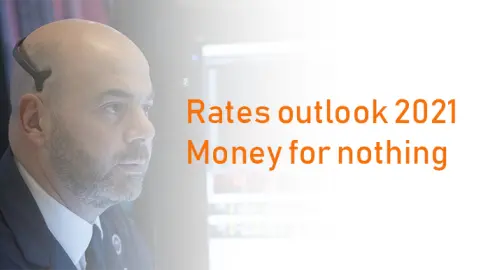EUR sovereign spreads: The carry sweet spot
ECB and EU support, exceeding governments' funding needs in most cases, will continue to drive sovereign spreads tighter in 2021; in the case of Italy to 90bp, its tightest level in a decade. Spain and France have less scope to perform
ECB and EU support to remain the key drivers of spreads
Another, hopefully, lasting consequence of the Covid-19 pandemic was the joint EU fiscal response. The programme, dubbed NGeu (Next Generation EU), includes €350bn of cross border transfers over several years. If the annual disbursed amounts over the life of the programme are relatively modest compared to the size of the eurozone economy as a whole, its impact on smaller peripheral economies, Greece for instance, is nothing short of a game changer. Even for larger peripheral countries, the combination of supply reduction, fiscal stimulus, and monitoring is sending a positive signal to investors.
ECB intervention to steamroll spreads further
If NGeu helps address the reasons for intra-eurozone sovereign spreads, namely diverging growth and fiscal paths, it doesn’t solve them entirely. In that respect, the ECB is once again proving instrumental in suppressing peripheral borrowing costs and preventing further divergence. It is also the prospect of sustained central bank support that pushes private investors into chasing yields lower.
Higher yielders on the front foot
We see no major impediment to this dynamic continuing next year. On the contrary, still sizeable central bank support, some degree of fiscal solidarity between states, and too shallow a recovery to question either, will serve carry trades well. As more investors are drawn to peripheral debt, we expect the 10Y spread between Germany and Italy to narrow to 90bp by the end of 2021. This would be its tightest level since the onset of the sovereign debt crisis over a decade ago. To arrive at this forecast, we assume that Italian political risk will remain in check, with no general election before 2022, but most likely in 2023.
| 90bp |
The Italy-Germany 10Y spread (end-2021 forecast)It tightest level in a decade |
Safer sovereigns, France and Spain for instance, will fare comparatively less well. This is in part due to competition for investor demand stemming from EU debt issuance, and in part because of the economic damage wrought by the pandemic.
Net financing needs versus ECB buying and EU financial support

Countries' crisis costs are more than absorbed by ECB and EU support
The European Commission forecasts net new financing needs of €760bn for eurozone countries in 2021, less than the €982bn anticipated for 2020, but still more than the €74bn in 2019.
However, the ECB stands to largely cover the pandemic's financial cost. Add EU support to this - for the chart below we consider the EU loans to support employment (SURE) and the grants from the EU recovery fund (NGeu) - and the overall financing balance looks decidedly more encouraging.
On aggregate, over €1.1 trillion in ECB and EU support far outweighs €760bn in net financing needs.
Crucially, the support extended to Italy and Spain is likely to exceed their 2021 net financing needs. This provides a substantial buffer in times of heightened uncertainty, especially if one considers the added possibility of pandemic emergency loans via the ESM (European Stability Mechanism) and loans from the EU recovery funds.
Germany stands to benefit substantially as well, thanks to the ECB buying bonds in proportion to each country's economy (the famed capital key). For a short period of time, the ECB has the flexibility needed to intervene where necessary. When this is the case, realignment of its portfolio holdings is postponed until market conditions allow it.
One caveat remains. The EU will have to finance its support in the market via bond issuance, in 2021 that could amount to €165bn of supply that will likely compete for the same investor base as core- and semi-core government borrowing. One more reason for higher yielders in the periphery to outperform.
This publication has been prepared by ING solely for information purposes irrespective of a particular user's means, financial situation or investment objectives. The information does not constitute investment recommendation, and nor is it investment, legal or tax advice or an offer or solicitation to purchase or sell any financial instrument. Read more
Tags
Rates outlookDownload
Download article
19 November 2020
Rates Outlook 2021: Money for nothing This bundle contains 12 Articles
